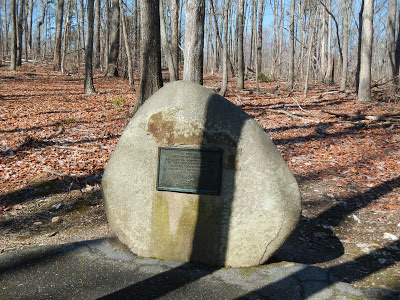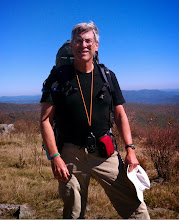Tucked up against the border with North Carolina near the South Carolina high country is the Revolutionary War battlefield of Kings Mountain. Whether you are familiar with this battle or not, it is considered of critical importance as American rebels defeated not the British army, but American loyalists - Americans loyal to the King of England. Thus, it was essentially a civil war action between neighbors and kinsmen. And it led to the British evacuation of the south and abandonment of their plans to win the American Southeast over with loyal subjects. Ultimately, it led to the surrender of General Cornwallis at Yorktown, Virginia almost exactly one year later. General Henry Clinton, British Commander in Chief of North America, later said about the defeat at Kings Mountain: "It was the first link in a chain of evils that ended in the total loss of America."
Prior to this battle, American rebel forces had been reeling in the south. In May, 1780, the British had easily occupied Charleston, SC - the fourth largest city in America - and captured 5,500 American military prisoners in the process. A couple of weeks later near Waxhaws, SC, a British force under Banastre Tarleton annihilated an American force of 400 - slaughtering and maiming several hundred after they attempted to surrender under a white flag, and leaving the wounded to die on the battlefield. In August, near Camden, SC, General Horatio Gates was soundly defeated by a smaller British force and lost more than a third of his army of 3,000. And along the way, guerrilla bands and partisans clashed in brutal fights, complete with looting, burnings, torture, and murder as neighbors fought neighbors.
About this time, Colonel Patrick Ferguson, a Scotsman and the only Brit to participate in the Battle of Kings Mountain, was given command of a large force of American loyalists. A hundred or so were from the northeast and were trained in British Army tactics and wore red coats. The majority were locals and wore frontier garb. They were issued British Brown Bess muskets with bayonets and also trained in infantry tactics. Here are a few interesting facts that I learned about Colonel Ferguson:
- He was reported to be the best shot in the entire British Army.
- In 1776, he patented a remarkable breech loading rifle. It could be loaded and fired from the prone position, which had not been possible before. It could be fired six times a minute, double the rate for a well-trained soldier with a musket. And the rifling made it much more accurate than a musket.
- Just before the start of the Battle of Brandywine Creek in 1777 in Pennsylvania, Ferguson had his rifle trained on an American officer on a horse. He was within a range that Ferguson reportedly said he could hit a piece of paper 10 out of 10 times. Before he pulled the trigger, the officer turned and began to ride slowly away. Ferguson did not shoot, thinking that it was an act of cowardice to shoot a man in the back. The officer who's life he spared was none other than George Washington!
But Ferguson made a bad mistake in September of 1780. He proclaimed that if the "backwater men" of the mountains of South Carolina "did not desist from their opposition to British arms, he would march his army over the mountains, hang their leaders, and lay waste to their country with fire and sword." About one-third of the population had stayed neutral up to that point, but the tough and independent Scotch-Irish of the Appalachians saw this comment as a direct threat to their lives and livelihoods, and were enraged. So they headed east, some of them traveling through total wilderness for 200 miles to join the fight. At the end, a group of 900 of the best riflemen, with William Campbell of Virginia commanding, pressed on all night during a soaking rainstorm with their rifles wrapped in blankets to keep them somewhat dry.
Ferguson and his army of 1,100 were waiting on the summit of Kings Mountain. It seemed like a ideal defensive position to this 20 year career army veteran. About 100 of his American troops wore the redcoat and the rest were in typical backwoodsman garb. To differentiate them from their backwoodsmen American rebel opponents (who wore a piece of paper in their hatbands), the loyalists wore a spring of pine in their hats. The rebels (or from our perspective, patriots) arrived just after noon on October 7 after their rainy forced march. The wet forest softened the sound of their footsteps and they surprised Ferguson and his men They encircled the mountain to cut off avenues of escape and began their advance about 3PM.
An hour later, it was over. It was the accurate rebel long rifle and guerrilla fighting tactics among the large trees against horribly inaccurate smooth bore British muskets and massed British infantry tactics. Even normally terrifying bayonet charges by the loyalists failed to break rebel resolve, and with their long rifles, they picked off the enemy forces who were silhouetted against the sky at the mountain top. Ferguson was hit several times late in the battle and perished. At that point, the second in command ordered a white flag raised, but the patriot commanders could not control their men for several minutes, and many loyalists were slaughtered while attempting to surrender. One of them made a last entry in his diary: "The cursed rebels Came upon us killed and Took every Soul and So My Dear friends I bid you farewell for I am Started for the warm Country."
The battlefield was just a few miles from Interstate 85 in northern South Carolina on my trip home from
Greenville, so I had to check it out. There is an excellent 1.5 mile long loop trail with great interpretive signs that goes through the forest - first from the position where patriot forces gathered to attack, and then along the crest of the Kings Mountain summit. I highly recommend it, as well as spending time in the fine museum and watching the film. It was a nice way to break up my 400 mile long drive, and I wish I had had more time there.
If I'd had more time, I would have hiked more. There is a 16 mile backcountry loop, with a remote campsite on it, that goes through the battlefield park and Kings Mountain State Park. Because of my long drive, I missed a chance to do a 4 mile hike here which would have qualified it towards several of my
2013 hiking goals. But because I couldn't do at least four miles of hiking there, I won't count it toward any of my goals.
Here are some photos of my tour of Kings Mountain.
A snowball? In March? In South Carolina?
Yep, sure is! I told you that it was cold and rainy during my
Saturday walk in Greenville, and this area was just high enough in elevation to get snow and sleet.
At the time of the battle, the trees here would have been even bigger than they are now, and it would have been wilderness. You can see how rugged the terrain is here where they fought. Coming here from 200 miles away up in the mountains would have been one rough trip by very tough people - no tents, no sleeping pads, no backpacks, no fancy, warm clothing or raingear. Just a bedroll, a few staples, a rifle, powder and shot.
While the mountain was heavily forested with big trees, in 1780 the summit was nearly treeless. Thus the advancing patriot forces had cover while the loyalists on the mountain top were exposed to accurate rifle fire with nothing to hide behind.
At this spot in 1930, the 150th anniversary of the battle, President Herbert Hoover addressed a crowd of 70,000 from this spot. Can you imagine that in this wild and remote area? The audience was the largest ever on the East Coast up to that time.
This is one of two memorials to the victory on the summit of Kings Mountain.
Colonel Patrick Ferguson, the only British subject to participate in what was essentially a civil war battle, died at this spot on October 7, 1780.
This memorial to Ferguson is near the spot where he died, and was erected during Hoover's visit for the 150th anniversary. I like the sentiment expressed at the end: "This memorial is from the citizens of the United States of America in token of their appreciation of the bonds of friendship and peace between them and the citizens of the British Empire." Here, here!
In the museum is this display of Ferguson's innovative breech loading rifle. Only about 150 were manufactured after its patent in 1776.


















































